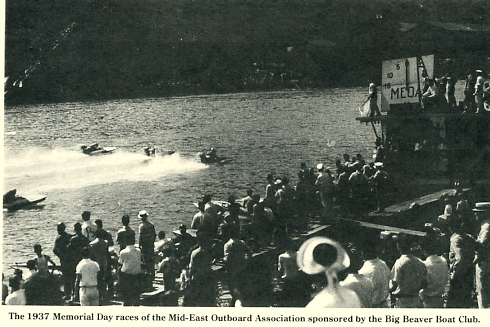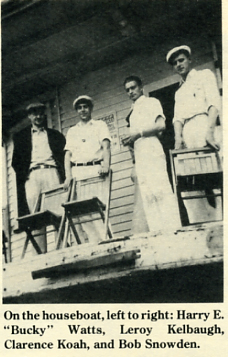
Click Here to Return to Milestones
A used houseboat stuck in the mud on a bank of the Beaver River 60 years ago was the start of the many boating clubs and marinas that bring so much pleasure today to the Beaver Valley. Credit a group of energetic young men from New Brighton - and the perennial floods of the Ohio - with that story. Floods helped shape the history of Beaver Valley. And it was floods, and the problems they brought to commercial navigation, that convinced the Army Corps of Engineers to propose building the Montgomery Island Dam.
Shortly before the new dam was finished in June 1936, my father, Leroy Kelbaugh, read newspaper articles about how the dam would create a pool of deep water stretching more than 18 miles upstream to the older dam near Sewickley. The new dam was designed to replace three smaller dams that did not have the capacity to control the frequent floods that had devastated the valley so often in the past.
Dad, then a young barber, aged 26, was particularly intrigued by the vision of that calm water and what it would mean for recreational boaters. He began talking to his friends about his idea to start a boat club.

By late 1936, he had organized a group of men and soon received a charter for the Big Beaver Boat Club. And even though he had never owned a boat in his life, Leroy Kelbaugh was elected the first commodore. He worked with his younger brother Karl Kelbaugh, friends Art and Ed Shaffer, brother-in-law Harry (Bucky) Watt, George Garmen, Harry Gestrich, Fred Kennedy, Roy Kaufman, Clarence Koah, Bob Snowden and Lyle Latshaw. All of them were from New Brighton except Karl, who lived in Rochester, and Bucky who lived in Riverview.
First they needed a place to establish their club. They chose the east bank of the Beaver River in lower New Brighton, just south of the 19th Street culvert under the Pennsylvania Railroad tracks. Then they needed a clubhouse. They decided to moor a used houseboat to the bank for their headquarters. Dad and several others pooled their money and traveled to Pittsburgh to buy a former government quarter boat. Then they negotiated with a tugboat operator to tow their craft down the Ohio and up the Beaver River.
On Christmas Day 1936, a cold, blustery day, this small group of adventurers boarded their boat to make the journey to their chosen site. Their voyage was without incident until they entered the mouth of the Beaver River and approached the old Sharon bridge, within a thousand yards of their destination. The bridge was still standing then, even though long closed to traffic. Concerned about the clearance overhead, the tugboat captain slowed down and called to the lookouts. Given the "all clear" signal, the captain resumed speed. Minutes later there was a loud snapping sound as the houseboat's flagstaff, mounted to the roof, was sheared away by the bridge structure. In a very short while the red-faced crew tied up to a stand of willow trees near the water's edge and started making plans to convert their new possession into a clubhouse.

But then the floods came. A series of heavy rains over the next several weeks threatened the houseboat with rising waters. At first the men reacted by simply adjusting their mooring. But the rains continued and the flooding turned serious. With the water rising, roads became flooded and the boat club members had to tend to other priorities and for a while they abandoned their work on the boat. Eventually the rain stopped and the river receded. When the men returned, they found their clubhouse high and almost dry on shore. It was at least 15 feet up the bank from the water and well imbedded in mud. Dad and two or three others began the long process of shoveling away the mud and jacking up the boat so they could winch it back down to the water.
At that point, Dad found out who was really in charge. He was working alone one day when a stranger walked up and identified himself as an officer with the Army Corps of Engineers. What Dad was doing was illegal, the man announced, because no one was permitted to alter the bank of a navigable stream without authorization. Dad was dumbfounded.
"We meant no harm, but we can't leave our boat here," he told the officer.
"Actually, you can," the corps officer replied. "Why not just straighten and lever her, then shore her up where she is?"
Dad thought the idea through for a minute or so, then agreed to do just that. And so, rather than floating, the first headquarters of the first boat club on the Beaver River sat snugly on the bank. One gangplank was placed to lead up from the bank to the deck and another down off the port side to a series of docks floating in the water. Dad and the other members had built the floating dock from 55-gallon drums, donated by several mills in the area, and discarded utility poles salvaged from the Duquesne Light Company.

The boat club was an immediate success. On Decoration Day (now Memorial Day) in 1936 they sponsored speedboat races in the Beaver River along a course extending north to the Fallston bridge and south to Blockhouse Run. The races drew such large crowds that people lined the bridge and both banks of the river. The races were so popular they were made a feature event of New Brighton's centennial celebration in 1938, and continued for several years afterward. Race crowds were so large that the club sought and received special permission from the Pennsylvania and the P&LE railroads for people to walk on their rights-of-way. And the railroads posted guards and ordered their trains to slow down during the races.
The club was financed by initiation fees and dues by members in addition to docking fees. Many nonmembers used the docks, including prominent citizens such as Arthur Mayer of Mayer China, who tied his large cruiser there for several years. The club also offered training in boating skills, navigation, and water safety. To provide security they hired a watchman, a former river boat hand, who lived aboard the houseboat for a while.
The Big Beaver Boat Club continued operating for six years. It disbanded in 1942 because of wartime restrictions. But anyone traveling today through the Beaver Valley will see its legacy - hundreds of private boats and many docks and marinas - and perhaps give a tip of the hat to the memory of those young men who started it all back in 1937.
NOTE: This article was written by James W Kelbaugh, from personal recollections, conversations with his father Leroy M Kelbaugh, and a modest amount of research from the files of the Beaver County Historial Society.